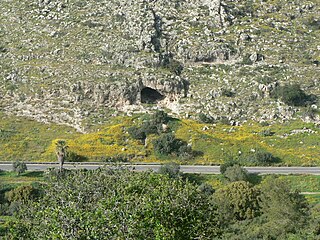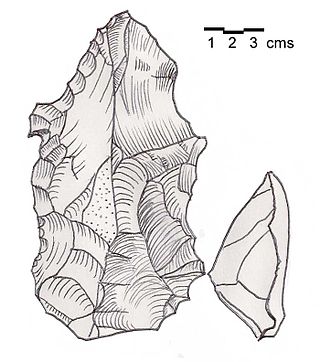
The Epipalaeolithic Near East designates the Epipalaeolithic in the prehistory of the Near East. It is the period after the Upper Palaeolithic and before the Neolithic, between approximately 20,000 and 10,000 years Before Present (BP). The people of the Epipalaeolithic were nomadic hunter-gatherers who generally lived in small, seasonal camps rather than permanent villages. They made sophisticated stone tools using microliths—small, finely-produced blades that were hafted in wooden implements. These are the primary artifacts by which archaeologists recognise and classify Epipalaeolithic sites.

The Neolithic or New Stone Age is an archaeological period, the final division of the Stone Age in Europe, Asia and Africa. It saw the Neolithic Revolution, a wide-ranging set of developments that appear to have arisen independently in several parts of the world. This "Neolithic package" included the introduction of farming, domestication of animals, and change from a hunter-gatherer lifestyle to one of settlement. The term 'Neolithic' was coined by Sir John Lubbock in 1865 as a refinement of the three-age system.

Natufian culture is a Late Epipaleolithic archaeological culture of the Neolithic prehistoric Levant in Western Asia, dating to around 15,000 to 11,500 years ago. The culture was unusual in that it supported a sedentary or semi-sedentary population even before the introduction of agriculture. Natufian communities may be the ancestors of the builders of the first Neolithic settlements of the region, which may have been the earliest in the world. Some evidence suggests deliberate cultivation of cereals, specifically rye, by the Natufian culture at Tell Abu Hureyra, the site of earliest evidence of agriculture in the world. The world's oldest known evidence of the production of bread-like foodstuff has been found at Shubayqa 1, a 14,400-year-old site in Jordan's northeastern desert, 4,000 years before the emergence of agriculture in Southwest Asia. In addition, the oldest known evidence of possible beer-brewing, dating to approximately 13,000 BP, was found in Raqefet Cave on Mount Carmel, although the beer-related residues may simply be a result of a spontaneous fermentation.

Pre-Pottery Neolithic B (PPNB) is part of the Pre-Pottery Neolithic, a Neolithic culture centered in upper Mesopotamia and the Levant, dating to c. 10,800 – c. 8,500 years ago, that is, 8800–6500 BC. It was typed by British archaeologist Kathleen Kenyon during her archaeological excavations at Jericho in the West Bank.

The Yarmukian culture was a Pottery Neolithic A (PNA) culture of the ancient Levant. It was the first culture in prehistoric Syria and one of the oldest in the Levant to make use of pottery. The Yarmukian derives its name from the Yarmuk River, which flows near its type site of Sha'ar HaGolan, near Kibbutz Sha'ar HaGolan at the foot of the Golan Heights. This culture existed alongside the Lodian, or Jericho IX culture and the Nizzanim culture to the south.

Nahal Oren is an archaeological site on the northern bank of the wadi of Nahal Oren (Hebrew)/Wadi Fallah (Arabic) on Mount Carmel, 10 km (6.2 mi) south of Haifa, Israel. The site comprises a cave and the small terrace in front of it, which steeply descends towards the wadi floor. The site was first excavated in 1941. Kebaran, Natufian (Epipaleolithic) and Pre-Pottery Neolithic A and B industries were found.
The Nachcharini cave is located at a height of 2,100 m (6,889.76 ft) on the Nachcharini Plateau in the Anti-Lebanon Mountains near the Lebanese/Syrian border and among the most elevated Natufian and Khiamian hunter-gatherer occupation sites found to date.
Abu Madi is a cluster of prehistoric, Neolithic tell mounds in Southern Sinai, Egypt. It is located east of Saint Catherine's Monastery at the bottom of a granite ridge. It was suggested to have been a seasonal encampment for groups of hunter gatherers and contained the remains of two major settlements; Abu Madi I and Abu Madi III. Abi Madi I is a small site with the remains of a partially buried 4 metres (13 ft) building containing deposits up to a depth of 1.3 metres (4.3 ft). Abu Madi III was an area of roughly 20 square metres (220 sq ft) that was excavated close to a large nearby boulder. Dwellings were found to have stone built silos next to them. It was first excavated in the early 1980s by Ofer Bar-Yosef.
Adrian Nigel Goring-Morris is a British-born archaeologist and a professor at the Hebrew University of Jerusalem in Israel.
Avi Gopher is an Israeli archaeologist. He is a professor at the University of Tel Aviv.
Horvat Galil is an archaeological site in the Upper Galilee, Israel, 13 kilometres (8.1 mi) from the coast of the Mediterranean.

Beidha, also sometimes Bayda, is a major Neolithic archaeological site a few kilometres north of Petra near Siq al-Barid in Jordan. It is included in Petra's inscription as a UNESCO World Heritage Site.
Iraq ed-Dubb, or the Cave of the Bear, is an early Neolithic archeological site 7 km (4.3 mi) northwest of Ajlun in the Jordan Valley, in modern-day Jordan. The settlement existed before 8,000 BCE and experimented with the cultivation of founder crops, side by side with the harvesting of wild cereals. Along with Tell Aswad in Syria, the site shows the earliest reference to domestic hulled barley between 10,000 and 8,800 BCE. The site is located on a forested limestone escarpment above the Wadi el-Yabis in northwest Jordan. An oval-shaped stone structure was excavated along with two burials and a variety of animal and plant remains.

Heavy Neolithic is a style of large stone and flint tools associated primarily with the Qaraoun culture in the Beqaa Valley, Lebanon, dating to the Epipaleolithic or early Pre-Pottery Neolithic at the end of the Stone Age. The type site for the Qaraoun culture is Qaraoun II.
Wadi Tahuna is an archaeological site of the Tahunian culture that was excavated in 1928 by Denis Buzy, several kilometers south to Bethlehem in Palestine.
Denis Buzy was a French archaeologist who excavated the Tahunian culture at Wadi Tahuna near Bethlehem in 1928.
Nahal Issaron is a wadi and neolithic settlement in southern Negev, Israel. It is located at the eastern edge of Ovda Valley, 35 kilometres (22 mi) north of the Gulf of Elat and 5 kilometres (3.1 mi) west of Arabah Rift valley. Excavations carried out by Avi Gopher and Nigel Goring-Morris in Nahal Issaron in 1980 uncovered remnants of an early pastoralist settlement belonging to the Pre-Pottery Neolithic B period.
The Wadi Rabah culture is a Pottery Neolithic archaeological culture of the Southern Levant, dating to the middle of the 5th millennium BCE.

The Nizzanim culture is a suggested archaeological culture from the Pottery Neolithic of the Southern Levant. It was identified in three sites spread over a small area on the southern coastal plain of modern Israel, including the type site of Nizzanim, Giv'at Haparsa, and Ziqim. The sites were studied by Ya'akov Olami, Felix Burian, Erich Friedman, Shmuel Yeivin, and Yosef Garfinkel. In those sites, there were no architectural remains but pits and floor levels with hearths. These findings seem to represent a pastoral-nomadic population, similar to the precedeeing population of Pre-Pottery Neolithic Ashkelon and the Qatifian culture. Garfinkel suggests that these settlement served as seasonal hunting or fishing campsites.
Wadi Hammeh 27 is a Late Epipalaeolithic archaeological site in Pella, Jordan. It consists of the remains of a large settlement dating to the Early Natufian period, about 14,500 to 14,000 years ago.









